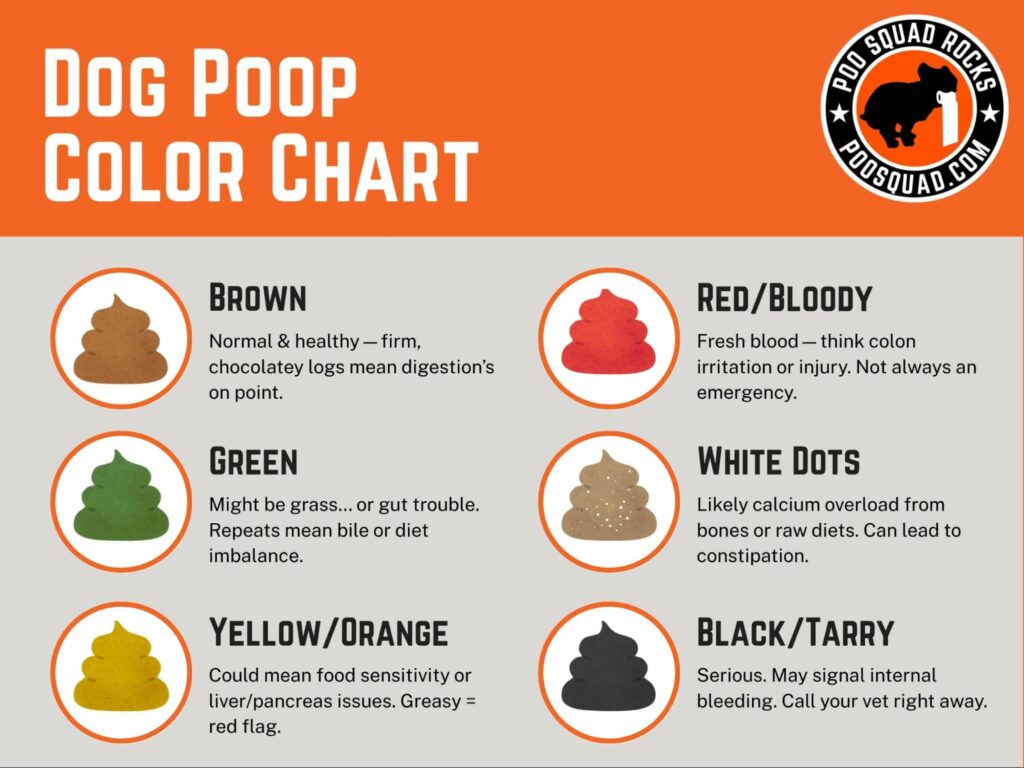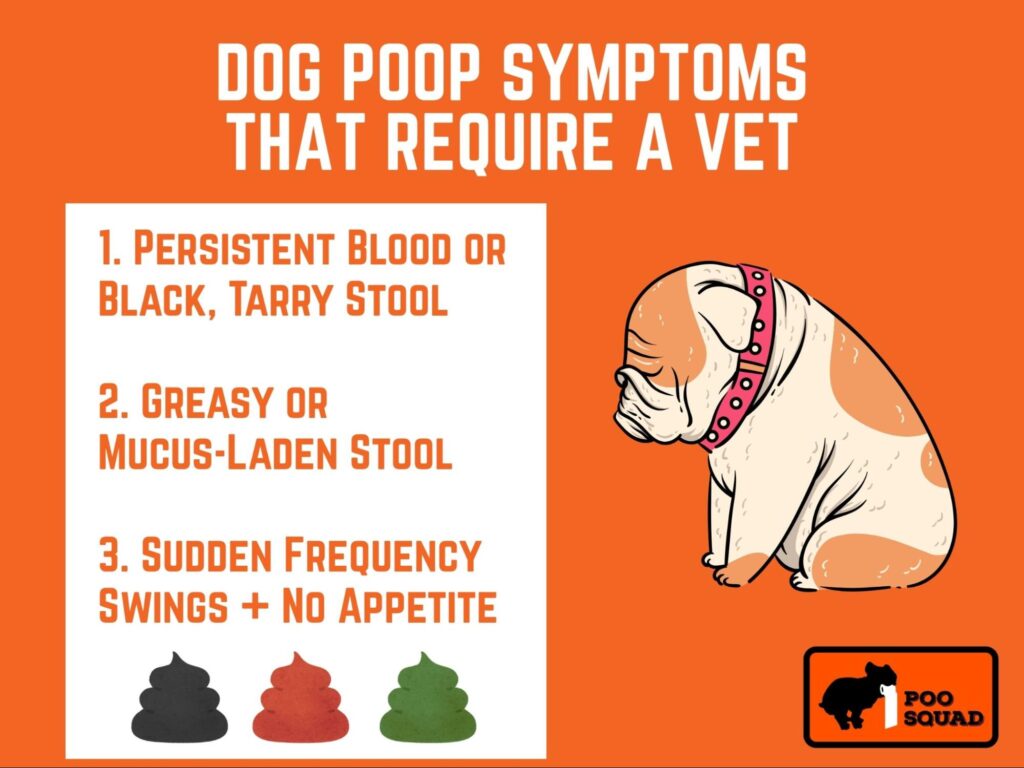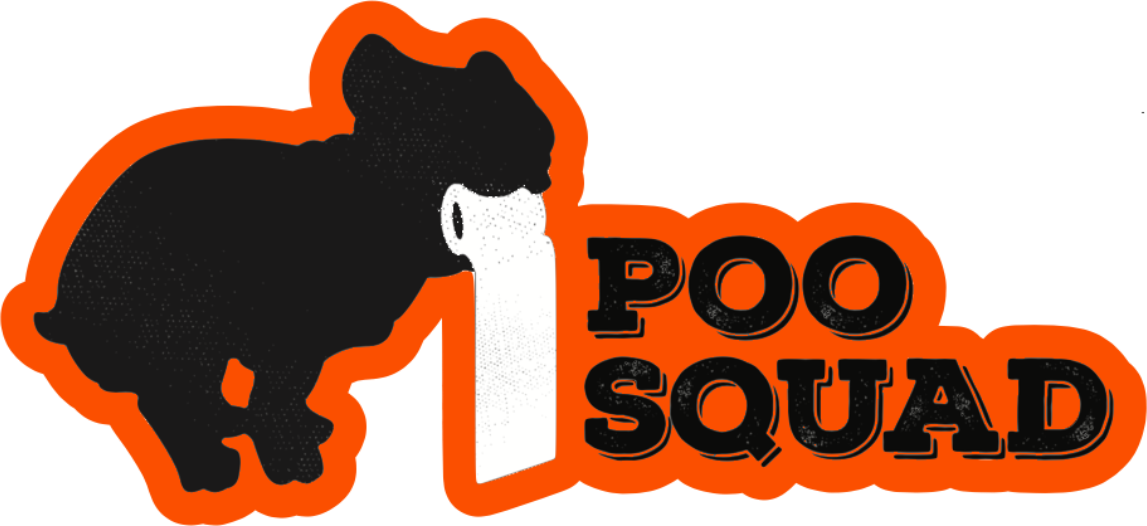Your dog’s poop is a daily health report. From color and texture to smell and frequency, each change can reveal digestive issues, nutrient problems, or early signs of disease. Learn how to decode poop clues, and when it’s time to call your vet.

Dog poop might seem like an afterthought, but it’s often your dog’s first (and only) way of telling you something’s wrong. Healthy poop is firm, chocolate brown, and easy to scoop. But when it turns runny, oddly colored, or starts smelling metallic? That’s more than a mess, it’s a message.
Changes in stool can indicate anything from a diet issue to parasites, liver dysfunction, or internal bleeding. You don’t need to panic at every puddle, but knowing what’s normal, and what’s not, can help you catch serious health concerns early.
Healthy Dog Poop vs. Problem Poop
There’s a gold standard for what healthy dog poop should look like, think firm, brown, and shaped like a log. Not too hard, not too soft. Easy to scoop, nothing weird inside, and doesn’t leave residue behind.
But if you’re spotting anything off-color, slimy, crumbly, or sparkly (yep, it happens), it might be time to pay closer attention. Poop that suddenly shifts in shape, shade, or smell can be your dog’s first way of saying, “Hey, something’s not right.”
Here’s a quick breakdown:
| Feature | What’s Normal | When to Worry |
| Color | Rich brown | Yellow, black, green, red, chalky white |
| Consistency | Firm but flexible log shape | Runny, mucus-covered, rock-hard, greasy, or oddly textured |
| Contents | Uniform, no visible extras | Fur, grass, worms, white specks, undigested food, weird items |
| Smell | Mild to earthy | Strong metallic, sour, or unusually foul |
| Frequency | 1–3 times daily | Sudden increase, decrease, or inconsistency |
This chart is the starting point. Below, we’ll dive into each poop clue, from suspicious shades to what it means when your pup leaves behind a pile of glitter.
The Color Code: What Each Poop Color Means for Your Dog
Not all dog poop is created equal. When it changes color, your dog’s digestive system is dropping hints, some harmless, others worth calling your vet about. Here’s what each shade typically says about your pup’s health:
Brown: The Gold Standard
This is what you want. Rich, chocolatey brown with a firm, flexible shape means everything’s running smoothly from mouth to tail. No alarms here.
Green: Grass, Gallbladder, or Gut Issue?
Sometimes it’s a grass-snacking habit. But green stool can also point to bile imbalance or rapid transit through the digestive tract. If it keeps showing up, it’s worth noting, especially if your pup’s been vomiting or having appetite swings.
Yellow or Orange: Liver Trouble or Food Intolerance?
Yellow or orange poop can be linked to issues in the liver, pancreas, or bile ducts. Sometimes it’s a food sensitivity. If it’s mushy or greasy, and especially if your dog seems otherwise fine but it keeps happening, it may signal something deeper than a diet hiccup.
Black or Tarry: Internal Bleeding Red Flag
This one’s serious. Black, tar-like stool can mean blood is being digested from the upper GI tract. It’s often a sign of ulcers or internal bleeding. If you see this, stop scrolling and call your vet.
Red or Bloody: Colon Irritation or Injury
Bright red streaks usually mean fresh blood from the lower intestine, colon, or rectum. It could come from straining, inflammation, or even a small tear. Be sure it’s not food dye from treats, yes, red velvet cookies for dogs exist.
Chalky or White: Too Much Calcium
Often seen in dogs on raw food diets or eating lots of bones, white or chalky stool might mean calcium overload. If it’s crumbly or causes constipation, a nutrition check might be in order.
Texture & Consistency: What Poop Shape Says About Health
Even when the color checks out, texture can tell another story. Poop that’s too soft, too hard, or oddly shiny is often your dog’s way of signaling digestive distress. Here’s how to read the signs, without needing a microscope.
Firm & Log-Shaped: Ideal Health Marker
The gold standard. Firm yet squishy, well-formed, and easy to pick up without residue. If this is what you see most days, your dog’s diet and digestion are doing fine.
Runny or Liquid: Diarrhea Signals
Loose stools happen, stress, parasites, dietary changes, or even too many treats can all be culprits. If it’s a one-off after a new snack, no panic. But chronic puddles? That’s a sign to look deeper.
Can poop change from stress or treats?
Absolutely. Dogs can react to emotional shifts or rich foods like humans. The key is watching if it clears up quickly, or keeps coming back.
Hard, Pebble-Like: Dehydration Warning
Dry, crumbly poop often means your dog isn’t getting enough water or fiber. It’s especially common in colder months or with older pups who drink less. Add hydration and check food quality if this shows up often.
Mucus-Coated: Colon Inflammation
A slimy, jelly-like coating usually points to inflammation in the colon. You might see it alongside straining or smaller stool size.
Is mucus just digestion?
Some mucus is natural, but if it’s frequent, thick, or paired with other symptoms, it may signal irritation or infection in the lower intestine.
Greasy or Shiny: Fat Malabsorption
If the poop looks oily or has a slick sheen, it could be excess fat that wasn’t properly digested. This often ties back to the pancreas. Fatty stools may float, too.
Firm Outside, Soft Inside: Inconsistent Digestion
This split-texture stool often signals poor-quality food or sudden diet changes. It might also show that food’s moving too fast through the system to be fully processed.
The Secret Inside: What’s In the Poop?
Sometimes, it’s not the color or texture that sends up a red flag, it’s what’s hiding inside. From wriggling specks to backyard art installations, your dog’s poop can reveal more than you bargained for.
Worms or White Specks
If you see rice-sized white flecks or actual squirming worms, it could be tapeworms, roundworms, or another type of parasite. Even indoor dogs can pick these up. A quick stool sample and deworming plan from your vet can usually solve it.
Undigested Food
Visible chunks of kibble or veggies mean something didn’t fully break down. It could be your dog eating too fast, or their system struggling to absorb nutrients. Slowing down mealtime and choosing better-quality food often helps.
Grass or Fur
Some grass here and there is normal, dogs often nibble it to soothe an upset stomach. But if you’re seeing fur in their stool, it could be from overgrooming, which may point to allergies, anxiety, or a skin issue.
Crayons, Toys, Socks: “Poocasso” Poop
Yes, this happens. If your dog’s droppings look like a craft project, boredom or pica may be the root cause. Dogs sometimes eat non-food items like crayons, fabric, or plastic out of curiosity, or stress. It’s funny until it’s not. Keep an eye on their behavior, and consider more mental stimulation during the day.
Pro tip: Creating a pet profile with contact info can help others get your dog home fast if their curiosity takes them on an unexpected adventure.
Behavioral and Environmental Clues
Poop doesn’t reflect what your dog eats, it also mirrors how they feel and where they’ve been. Changes in routine, surroundings, or emotions often show up in the yard before they show up in behavior.
Frequency & Timing
Most healthy dogs go 1–3 times per day. A sudden increase or decrease can be your first clue that something’s up. Maybe they’re adjusting to a new food, reacting to a stressful event, or aging into a new rhythm. When in doubt, look at patterns, not one-off poops.
Travel, New Homes, or Visitors
Dogs thrive on consistency, so travel, boarding, houseguests, or even a new pet can throw off their digestive groove. Soft or infrequent stools during these times are common, and usually temporary.
Why does poop change after boarding or staying with others?
New smells, unfamiliar schedules, anxiety, or different food can all cause shifts. It’s often nothing to panic over, something to watch.
Sudden Poop Shifts
Not every change is a crisis. If you notice a new color, texture, or frequency, consider recent events: did you try a new treat? Start medication? Swap their food? These shifts often resolve on their own, but they’re still worth noting in case patterns emerge.
When To Worry: Poop Symptoms That Require a Vet
Most weird poops are one-and-done events. But some symptoms should trigger a call to your vet, especially when they come with changes in appetite, behavior, or energy. Here’s how to know when it’s not a passing phase.

Persistent Blood or Black, Tarry Stool
Bright red usually means irritation in the lower digestive tract. But black, sticky stool can signal bleeding deeper inside, often the stomach or small intestine. If it happens more than once or pairs with fatigue, it’s time for a checkup.
Greasy or Mucus-Laden Stool
If your dog’s poop consistently has a shiny film or strings of mucus, and they seem sluggish or off their food, it could be inflammation, parasites, or even pancreas issues.
Sudden Frequency Swings + No Appetite
If your dog suddenly goes from one poop a day to five, or none, and they’re not eating, it’s a sign something’s off internally. You know your dog’s rhythm best. When it shifts hard and fast, pay attention.
Unusual Smells
Poop always stinks, but some odors cross a line. A metallic or iron-like scent can be a sign of blood. Other sharp chemical smells could mean digestive trouble. Trust your nose, if it’s not normal, get it checked.
Common Myths That Mislead Dog Owners
Some things won’t flush. These common beliefs sound harmless but actually cause confusion, poor hygiene, or even health issues. Let’s clear the air, myth by myth.
“Dog Poop Is Fertilizer”
Not even close. Unlike cow manure, dog waste is highly acidic and loaded with bacteria like E. coli and parasites. It kills grass, contaminates soil, and pollutes waterways. Chopping it up with a mower spreads the problem faster.
“Only Rich People Hire Scooping Services”
Dog poop doesn’t care about your tax bracket. Services are often used by busy families, working moms, and people with mobility issues, not those with money to spare. It’s about saving time, not showing off.
“You Can Start a Million-Dollar Poop Biz with $100”
There’s a reason some folks fall for this one, it makes for a great headline. But in truth, building a reliable service takes tools, branding, systems, and stamina.
“Only Lazy People Outsource Poop Pickup”
No one calls a lawn care crew lazy. Delegating this task is about health, convenience, and preserving your Saturday morning. In fact, some families say hiring a scooping service has reduced stress and fights at home.
Worries People Have (And Why They’re Valid)
If you’ve been worried, confused, or even ashamed, you’re not alone. These concerns come up more often than you think:
“I ignored poop changes and now I’m panicking”
Guilt hits hard when you realize something’s been off for a while. But here’s the good news: catching it now is better than never. Dogs are resilient, and most issues can be managed if caught early.
“I can’t afford a false alarm at the vet”
Totally valid. Vet visits aren’t cheap, which is why knowing what’s normal, and what’s not, can save money and stress. Tracking changes with consistency can help you avoid unnecessary visits and catch real problems sooner.
“What if I’m just overthinking normal poop?”
There’s a fine line between caution and worry. But poop is a health signal. If something looks odd but your dog is acting normal, note it and monitor for patterns.
“I’m embarrassed to ask anyone about this”
It’s awkward. But the health of your dog, and your peace of mind, matter more than pride. Services that provide poop tracking or visual logs can give you what you need to start the right conversation with your vet.
“I’ve been too depressed to clean up poop, now it’s overwhelming”
Life gets heavy. The backyard doesn’t judge. Sometimes self-care means asking for help, whether that’s a cleanup crew or a plan. Letting go of guilt is the first step to getting back on track.
What to Do Next
You don’t need to memorize every poop texture and color code. Start by noticing patterns. Keep a photo log, or better yet, let someone do it for you.
With Poo Squad’s Dog Poop Report Cards, pet profiles, and sanitation-first service, you’ll get health insights without lifting a scooper. It’s a simple way to stay ahead of problems, and get peace of mind back.
- When in doubt, take a photo
- Watch for changes
- Ask for help when you need it
Because behind every weird poop is a story your dog can’t tell, but you can learn to read.
